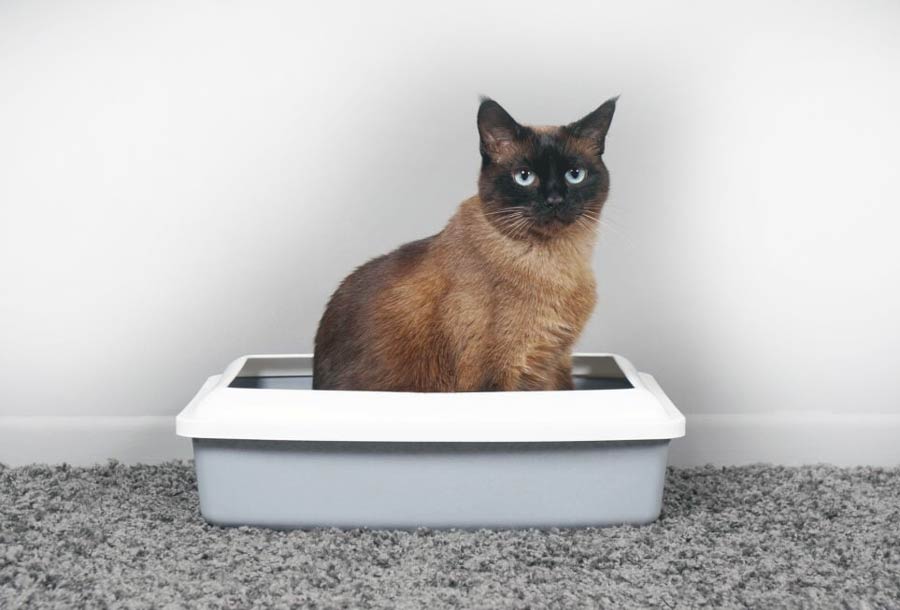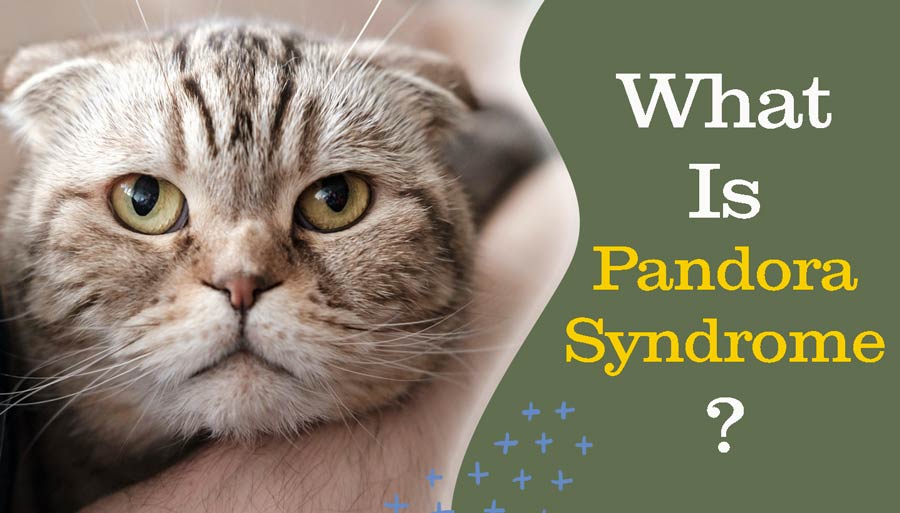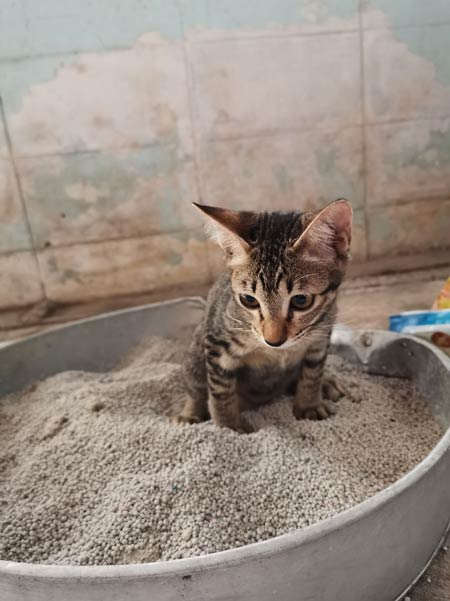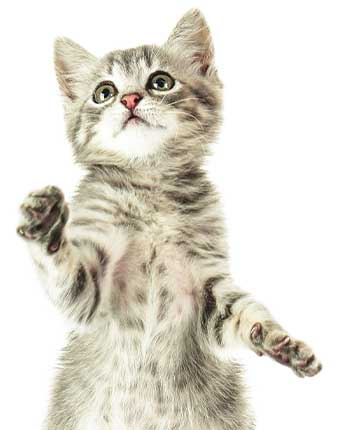Simba’s Urinary Problems
In June 2001, Simba was licking his rear end and visiting the litter box frequently. He ran urgently to the box every few minutes for an hour in the middle of the night. He’d try to urinate, but only a few drops would pass. Sometimes nothing at all. He’d even occasionally yowl as if he was in pain while he was trying to urinate.
That night his guardian found drops of urine on the floor near the box. Some of these were pink and seemed to contain blood. Simba seemed fine otherwise and ate a good breakfast the next morning. Nevertheless, he was stuffed in a little cat carrier and whisked away to his regular vet later that day.
Simba’s exam was normal, and the vet advised a urinalysis to check for a urinary problem. A few drops of pink cloudy urine were on the stainless steel exam table. The small sample was thick and showed microscopic crystals and blood.
No urine culture was done and no bacteria were seen, but the vet diagnosed a bladder “infection” and dispensed antibiotics. These were given and the urinary problem quickly resolved. Simba seemed fine for a while. A few months later, the same problem returned.

Recurrence Is Common
This is an all-too-common scenario. Urinary problems in cats are a huge clinical and household management problem. Here, we’re going to show how a vitality, balance, and homeopathic approach allowed Simba’s guardian to better understand Simba’s health challenge and how to help him.
Simba continued to have similar recurrent urinary symptoms, especially in the fall, which is a common time to see feline urinary symptoms. This observation is typically left unexplained in conventional veterinary medicine, but vet homeopaths understand that this is a modality: an expression of Simba’s individuality, including his circadian rhythms and internal clock.
In the fall of the following year, he became unable to urinate. He would cry and strain unproductively in the box. His guardian thought he might be constipated but wisely went right to her vet.
Simba was unable to urinate. His urinary obstruction had caused toxins to back up in his blood. Fortunately, a urinary catheter immediately enabled him to urinate and intravenous fluids flushed his blood clean of uremic (from the kidney) poisons.
Simba went home and was doing great. Then one day just a few months later he started to strain again. Another emergency vet visit revealed a blockage again. This time, though, it was difficult to pass a urinary catheter. The local vet advised surgery and referred him to a surgical specialist for a perineal urethrostomy (removal of the narrowest part of the urethra by amputating the penis).
His mom wanted to avoid surgery if at all possible. Here is where homeopathic and holistic care helped avoid surgery and promoted deep healing to prevent future urinary issues. Read more about Simba’s healing below, and first learn more about urinary dis-ease.

Enter Pandora
Recently, a lecture by an eminent veterinary urologist introduced me to Pandora Syndrome (PS). He had helped coin this term, using it to describe a syndrome that included all of Simba’s symptoms which had previously been classified as Feline Urinary Syndrome (FUS), Feline Lower Urinary Tract Disease (FLUTD), Feline Idiopathic Cystitis (FIC), etc.
Diagnosis, pathogenesis, and the physiologic changes seen in PS were discussed. Many of the earlier theories about cause were mentioned but discarded. Dietary ash, fish, magnesium, etc. were likely not important triggers. Wonderfully, this purely conventional veterinary scientist spent the majority of his allotted time making holistic lifestyle recommendations. Simple modifications such as enriching the environment were found to be helpful when managing PS.
Risk Factors for Pandora Syndrome
Simba’s urinary symptoms began in the summer, however, fall and the onset of cooler weather is associated with increased cases. Indoor and overweight cats are at a higher risk for PS. So are those in multiple cat households.
Simba had many of the typical PS signs. He was also a big boy. Some might say “big-boned” even. It’s a standard vet practice to initially prescribe antibiotics when these symptoms are seen. Unlike dogs, however, bacterial infections are rarely implicated in feline UTIs.
Antibiotics Are (But Should Not Be) the First Treatment for Feline Urinary Problems
In many cats, PS symptoms resolve with a special diet, antibiotics, anti-inflammatories, muscle relaxants, urethral dilators, and anti-anxiety medications. However, symptoms often return or never fully resolve. In these cases, most vets will then switch prescription diets and add other drugs. Some conventional vets may also recommend lifestyle changes.
This is a great conventional vet article summary by one of those that coined the name PS.
Holistic and Homeopathic Help To Close Pandora’s Box
- Ideal nutrition
- Weight loss
- Promoting happiness
- LItter box
- Mental stimulation
Many cats with urinary symptoms and diagnosis of FUS, FLUTD, FIC, PS, etc. can be helped by homeopathic and holistic treatment.
Preventing urinary problems before they start is the most effective way to address all of these.
“It Burns, It Burns…”
Cats are desert dwellers and evolved to be able to conserve fluids. One of their adaptations includes the ability to concentrate urine by allowing maximal water reabsorption of urine. Cat urine can therefore get very concentrated and irritating to the bladder wall.
The longer urine accumulates in the bladder, the greater the chance for urinary symptoms classified as cystitis.
Helping your cat maintain dilute urine can be critical when trying to prevent bladder irritations.
Not feeding dry food is the most important thing that you can do.
Evolutionarily many cats are not wired to have much urge to drink. Just changing from a primarily dry to a wet-based diet is essential. The best is to incorporate a fresh food and meat-based diet.
Some like Simba even allow extra liquids mixed in with the food or syringed in the mouth.
Obesity
Feeding a fresh food diet is the best way to help them lose weight, which can be a key step to preventing urinary tract problems.
Weight loss and changing to a wet and fresh food diet will help most cats with urinary symptoms.
HAPPINESS – It’s A Cat’s Life?
Your cat’s life might seem perfect to you, but unhappiness may be subtle and could be a trigger for urinary symptoms. Is your cat happy? Urinating outside the box and spraying are among the most common complaints that bring clients to the vet, which are symptoms of urinary dis-ease.
In my experience, the three most common causes for kitty urinary symptoms from unhappiness are:
- Litter box problems
- Overpopulation (too many cats in a small space)
- Boredom
Like their namesake, Pandora kitties can be overly emotional. Addressing all of these potential problems is critical when holistically treating PS.
Resolving Litter Box Problems
 Do everything possible to prevent avoidance of the litterbox. Some cats develop urinary symptoms and PS strictly because they are “stressed” about some aspect of using the litter box. Do your best to maintain an immaculate litter box. Ideally, scoop the box after every use. Empty and wash the box and refill it with brand new litter every week or two.
Do everything possible to prevent avoidance of the litterbox. Some cats develop urinary symptoms and PS strictly because they are “stressed” about some aspect of using the litter box. Do your best to maintain an immaculate litter box. Ideally, scoop the box after every use. Empty and wash the box and refill it with brand new litter every week or two.
You may need to try different litter types (clay vs. sand etc.) in addition to maintaining good litter cleanliness. Use an unscented litter as what smells pleasant to us is often aversive to your cat. There’s a good study that shows spraying Zero Odor in the box after cleaning increases litter box use.
Vet behaviorists that commonly treat PS cats have a rule of thumb. The rule is to always have one litter box more than the number of cats in your household. 2 cats=3 boxes. If you live in a small space, it can be difficult to have multiple cats, especially if one has urinary symptoms and needs an extra litter box but you have no place to put it. In this case, it’s very possible that your cat’s urinary symptoms are (at least partially) due to feline overcrowding.
Litter boxes should be in quiet spots in your house with easy access by your cat. It’s no surprise if your cat pees on the carpet because the door to the basement was closed. Areas, where there could be loud and sudden noises, can also be a problem. Move your boxes away from the washer and dryer, furnace, actively used toilets, etc.
Some multi-cat households contain bully cats. These can often be seen preventing litter box access to other cats. Be on the lookout and gently intervene if you see this.
Too Crowded?
Cats are not naturally pack animals, even though they may have kitty friends. One solution for multi-cat households is to create multiple levels and hang-out areas ( even cardboard boxes) in your home so that each cat or group of cats can avoid feeling crowded. “Catios” are an excellent way to expand the space available to improve happiness.
Is Boredom Causing Unhappiness?
Some years ago, the vet urinary researchers at OSU observed an association between environmental factors and urinary symptoms. Besides the litter box and inter-cat problems, they found that some smart cats were having recurrent urinary signs because of boredom.
Many cats are really smart. So smart that we need to be very creative to discover ways to interact with them.
Teaching them kitty agility and how to do hi-fives, playing fetch, taking them out for walks on a harness, singing along with you, and more. See below for a link to an hour-long video with other fun ideas.
Like people and dogs, each cat is unique, so seek the stimulation that each individual cat loves. Some cats even seem to love being read aloud to.
The indoor pet initiative also has many ways to improve your cat’s environment. Be sure to work both his brain and body to help prevent pet problems associated with lifestyle issues like PS.
Also, it is best not to reprimand your cat when it comes to inappropriate urination. Promote the positive and ignore the negative. Any interaction with your cat should be a good interaction.
What About Simba?
Simba was already on a great, varied, commercial raw diet. However, his urine was still concentrated. There were no other problematic environmental factors. Simba would not eat his food when extra water or chicken broth was added. Fortunately, he would accept extra fluids given by syringe. These kept his urine optimally diluted.
Internal medicinal homeopathic treatment was initiated. Simba’s urinary symptoms resolved and eventually, transient mild skin symptoms developed. At the same time his energy, mood, and overall vitality improved. He never needed surgery and never had other urinary symptoms or blockage, and his chronic skin symptoms “coincidentally” resolved.

